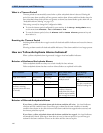
About the ST Measurement Points 6 ECG, Arrhythmia, and ST Monitoring
121
3
Use the Select Point pop-up key to scroll through the points and activate the point you need
to adjust, then use the left and right arrow keys to move the measurement point. Each point is
highlighted while active.
The ISO-point cursor positions the isoelectric point relative to the R-wave
peak. The relation is shown beside the ISO-point in milliseconds. Position the
ISO-point in the middle of the flattest part of the baseline (between the P and
Q waves or in front of the P wave).
The J-point cursor positions the J-point relative to the R-wave peak. It helps
you to correctly position the ST-point. Position the J-point at the end of the
QRS complex and the beginning of the ST segment.
The J-point cursor is not available if your monitor is configured to let you set
the ST point directly.
To position the ST-point relative to the J-point:
select either J+60 or J+80. Select J Point and use the arrow keys
to move the J-Point and position the ST-point at the midpoint of the ST
segment.
To position the ST-point directly:
select ST Point and use the left and right arrow keys to position the ST
point at the midpoint of the ST segment.
4 Select the Apply Changes pop-up key to activate the new ST measurement points and
recalculate all ST values.
The most recent ST Points adjustment time is displayed in the Adjust ST Points window.
This information is cleared when a patient is discharged or when a new Profile is loaded into the
monitor.
1mV
calibration
bar
Highlighted ST point
Timestamp of
most recent ST
point adjustment
ST-I
0.0
ST label and the ST
numeric that would
apply using the
current points
Adjust ST Points
ISO Point -80
J Point 48
ST Point J+60
ST Points adjusted at 04 Apr 03 11:38
Cursors for
adjusting ST
points
ISO


















